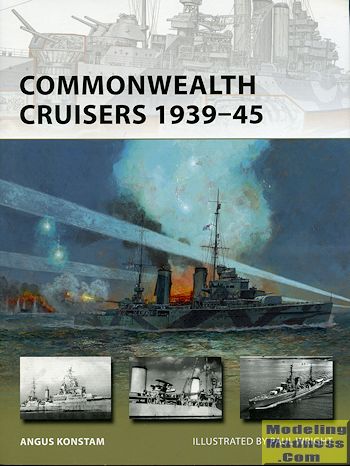 The
New Vanguard series is one of my favorites from the Osprey publishing group.
This particular edition covers Commonwealth Cruisers operated by countries of
the United Kindom's commonwealth of nations. Not all of these nations operated
ships of this size. For instance, South Africa had no need for anything that
large as they had little in the way of an ocean-going navy.
The
New Vanguard series is one of my favorites from the Osprey publishing group.
This particular edition covers Commonwealth Cruisers operated by countries of
the United Kindom's commonwealth of nations. Not all of these nations operated
ships of this size. For instance, South Africa had no need for anything that
large as they had little in the way of an ocean-going navy.
For that reason, the only countries that operated cruisers during the
war were Australia, Canada and New Zealand. These ships, for a considerable part
of the war, operated in conjunction with either the Royal Navy or, when Japan
entered the picture, the US Navy.
Australia operated more heavy ships than the other dominion navies. One
reason is that for much of the interwar period, the RAN was also responsible for
the defense of New Zealand, though that changed in the late 1930s. The RAN
operated three heavy cruisers: two Kent class ships, the Australia and the
Canberra as well as the London class cruiser, the Shropshire. There were also
four light cruisers. One was the Birmingham class HMAS Adelaide, then there were
three Perth class ships, the Sydney, Perth, and Hobart. These ships were rather
active during the war, first service in the Mediterranean, and then in the
waters around Australia. The Canberra was sunk at the Battle of Savo Island,
Sydney was sunk in an epic battle with the German raider Kormoran, while the
Perth was sunk during the Battle of the Java Sea. Hobart was hit by a Japanese
submarine and so damaged that she was out for most of the war.
The Royal New Zealand Navy operated two Leander class light cruisers,
the Leander and the Achilles as well as one Cape Colonly class light cruiser the
Gambia. These ships spent the early part of the war with the Royal Navy, the
Achilles being active at the Battle of the River Platte. She was transferred to
the Indian Navy at the end of the war.
The Royal Canadian Navy had little use for cruisers as most of their
naval war effort was escorting Atlantic convoys and for that task, destroyers
and smaller were much more useful. However, they did have two cruisers. There
were two Cape Colony class light cruisers. One was the HMCS Uganda, which
operated towards the end of the war with the British Pacific fleet. The other
was the HMCS Ontario which did not get into service until the last days of the
war.
The authors cover a history of the dominion navies prior to WWII then
the various classes of ships and their war record. The various modifications
made to these ships is also covered as some saw a rather long war career while
others did not. The book is full of period photos, some great illustrations of
the ships in action as well as the usual tables on each class of ship that is
the norm for this series. In all, it makes for a well done reference on these
ships and is a book that enthusiasts and naval modelers will find most useful.
September 2015
For more on the complete line of Osprey books,
visit http://ospreygrp.com. In the US, it is
Osprey Direct at 44-02 23rd St, Suite 219, Long Island City, NY 11101., where you can
get a catalogue of available books.
If you would like your product reviewed fairly and
fairly quickly, please
contact
the editor or see other details in the
Note to
Contributors.
 The
New Vanguard series is one of my favorites from the Osprey publishing group.
This particular edition covers Commonwealth Cruisers operated by countries of
the United Kindom's commonwealth of nations. Not all of these nations operated
ships of this size. For instance, South Africa had no need for anything that
large as they had little in the way of an ocean-going navy.
The
New Vanguard series is one of my favorites from the Osprey publishing group.
This particular edition covers Commonwealth Cruisers operated by countries of
the United Kindom's commonwealth of nations. Not all of these nations operated
ships of this size. For instance, South Africa had no need for anything that
large as they had little in the way of an ocean-going navy.